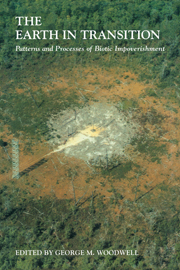Book contents
- Frontmatter
- Contents
- Preface
- Acknowledgments
- List of Contributors
- Part I Global Change and the Patterns of Impoverishment
- Part II Chronic Disturbance and Natural Ecosystems: Forests
- Part III Chronic Disturbance and Natural Ecosystems: Woodlands, Grasslands, and Tundra
- 14 Changes in the Mediterranean Vegetation of Israel in Response to Human Habitation and Land Use
- 15 Bromus tectorum, a Biotic Cause of Ecosystem Impoverishment in the Great Basin
- 16 Detecting Early Signs of Regional Air-Pollution Injury to Coastal Sage Scrub
- 17 Arctic Ecosystems: Patterns of Change in Response to Disturbance
- Part IV Chronic Disturbance and Natural Ecosystems: Aquatic and Emergent Ecosystems
- Part V Conclusion: Steps toward a World That Runs Itself
- Name Index
- Subject Index
15 - Bromus tectorum, a Biotic Cause of Ecosystem Impoverishment in the Great Basin
Published online by Cambridge University Press: 24 November 2009
- Frontmatter
- Contents
- Preface
- Acknowledgments
- List of Contributors
- Part I Global Change and the Patterns of Impoverishment
- Part II Chronic Disturbance and Natural Ecosystems: Forests
- Part III Chronic Disturbance and Natural Ecosystems: Woodlands, Grasslands, and Tundra
- 14 Changes in the Mediterranean Vegetation of Israel in Response to Human Habitation and Land Use
- 15 Bromus tectorum, a Biotic Cause of Ecosystem Impoverishment in the Great Basin
- 16 Detecting Early Signs of Regional Air-Pollution Injury to Coastal Sage Scrub
- 17 Arctic Ecosystems: Patterns of Change in Response to Disturbance
- Part IV Chronic Disturbance and Natural Ecosystems: Aquatic and Emergent Ecosystems
- Part V Conclusion: Steps toward a World That Runs Itself
- Name Index
- Subject Index
Summary
Editor's Note: Bromus tectorum is a desert annual, an exotic to North America. It offers us a classical case of biotic impoverishment: it is one of those small-bodied, rapidly reproducing, hardy plants that finds a variety of open niches around the world and changes the world. In this case, in the Great Basin of North America, its chance introduction is displacing an indigenous forest and a native shrubby ecosystem.
W. D. Billings has been a lifelong student of the vegetation of the earth, extending his insatiable curiosity and capacity for new knowledge with a continuing flow of equally intense and able students. Billings has been an especially avid student of deserts and tundra, both Arctic and montane. It is his lifelong interest in deserts that we have tapped here to draw out one of the best-documented and most important case histories of how one exotic has changed a landscape, reducing its potential for support of plants and animals, including people, for all of time.
Introduction
From the tropics to the boreal forest, the destruction of vegetation by clear-cutting or fire is a common occurrence. The resultant loss of floristic and faunistic diversity is, in the main, due to direct human interference and impact. Subtle invasions by pathogens or by most exotic animal and plant species more likely result in selective loss, one species at a time, as was the case with the loss of the American chestnut, Castanea dentata (Marsh.) Borkh., from the eastern deciduous forest due to attack by the Asiatic fungus Endothia parasitica
- Type
- Chapter
- Information
- The Earth in TransitionPatterns and Processes of Biotic Impoverishment, pp. 301 - 322Publisher: Cambridge University PressPrint publication year: 1991
- 8
- Cited by

